The Impacts of Severe Drought on Waterbirds: A Case Study for the White-Naped Crane in Poyang Lake Based on Satellite Telemetry
Abstract
1. Introduction
2. Materials and Methods
2.1. Study Area
2.2. Study Species
2.3. Crane Capture and Tracking
2.4. Hetero-Occurrence Species Distribution Models (HOSDMs)
2.4.1. Differentiate Occurrences
2.4.2. Prepare Environmental Data
2.4.3. Build HOSDMs
2.5. Comparing Daily Movement Distances
3. Results
3.1. Daily Activities
3.2. Output of Hetero-Occurrences Species Distribution Models (HOSDMs)
3.3. Comparing Daily Movement Distance Using a Mixed Effect Model
4. Discussion
4.1. Comparison with Other Studies
4.2. Crane Activities During the Extreme Drought
4.3. Application of HOSDMs
4.4. Debate About Dam Construction at Poyang Lake
5. Conclusions
Supplementary Materials
Author Contributions
Funding
Institutional Review Board Statement
Informed Consent Statement
Data Availability Statement
Acknowledgments
Conflicts of Interest
Appendix A
| Variables | Parameters | Unit | Citation | |||
|---|---|---|---|---|---|---|
| Mean | Minimum | Maximum | SD | |||
| Bio_1 (Annual Mean Temperature) | 17.4 | 11.4 | 18.8 | 0.8 | °C | |
| Bio_4 (Temperature Seasonality (standard deviation × 100)) | 870.5 | 804.3 | 918.1 | 19.7 | °C | |
| Bio_12 (Annual Precipitation) | 1556.9 | 1371 | 1912 | 90.1 | mm | |
| Bio_15 (Precipitation Seasonality (Coefficient of Variation)) | 57.6 | 48.5 | 63.4 | 3.1 | / | |
| Elevation | 85.1 | 0 | 1530 | 145.6 | m | |
| Human footprint index | 15.1 | 0.03 | 48.23 | 5.97 | / | |
| Solar radiation in January | 9324.2 | 8304 | 9843 | 277.5 | kJ m−2 day−1 | |
| Wind speed in January | 2.0 | 1.7 | 3.0 | 0.14 | m s−1 | |
| Water vapor pressure in January | 0.64 | 0.44 | 0.74 | 0.055 | kPa | |
| Land cover | / | / | / | / | / | [35] |
| Longitude | 116 | 115 | 117 | degree | ||
| Latitude | 29 | 28 | 30 | degree | ||
| npar | Sum Sq | Mean Sq | F Value | |
|---|---|---|---|---|
| Day | 1 | 357.59 | 357.59 | 658.54 |
| Winter | 7 | 504.94 | 72.13 | 132.84 |
| I (Day2) | 1 | 135.95 | 135.95 | 250.36 |
| Day:Winter | 7 | 70.17 | 10.02 | 18.46 |
| Year | Departure Dates (Mean Values of Julian Day) | Standard Deviation of Departure Dates | Number of Individuals |
|---|---|---|---|
| 2014 | 129.0 | 2.8 | 2 |
| 2015 | 131.8 | 32.7 | 4 |
| 2016 | 91.2 | 44.4 | 6 |
| 2017 | 63.5 | 14.0 | 6 |
| 2018 | 77.5 | 17.0 | 13 |
| 2019 | 73.5 | 11.9 | 33 |
| 2020 | 72.7 | 13.5 | 32 |
| 2021 | 66.8 | 17.6 | 25 |
| 2022 | 66.7 | 9.8 | 13 |
| 2023 | 51.2 | 15.4 | 11 |

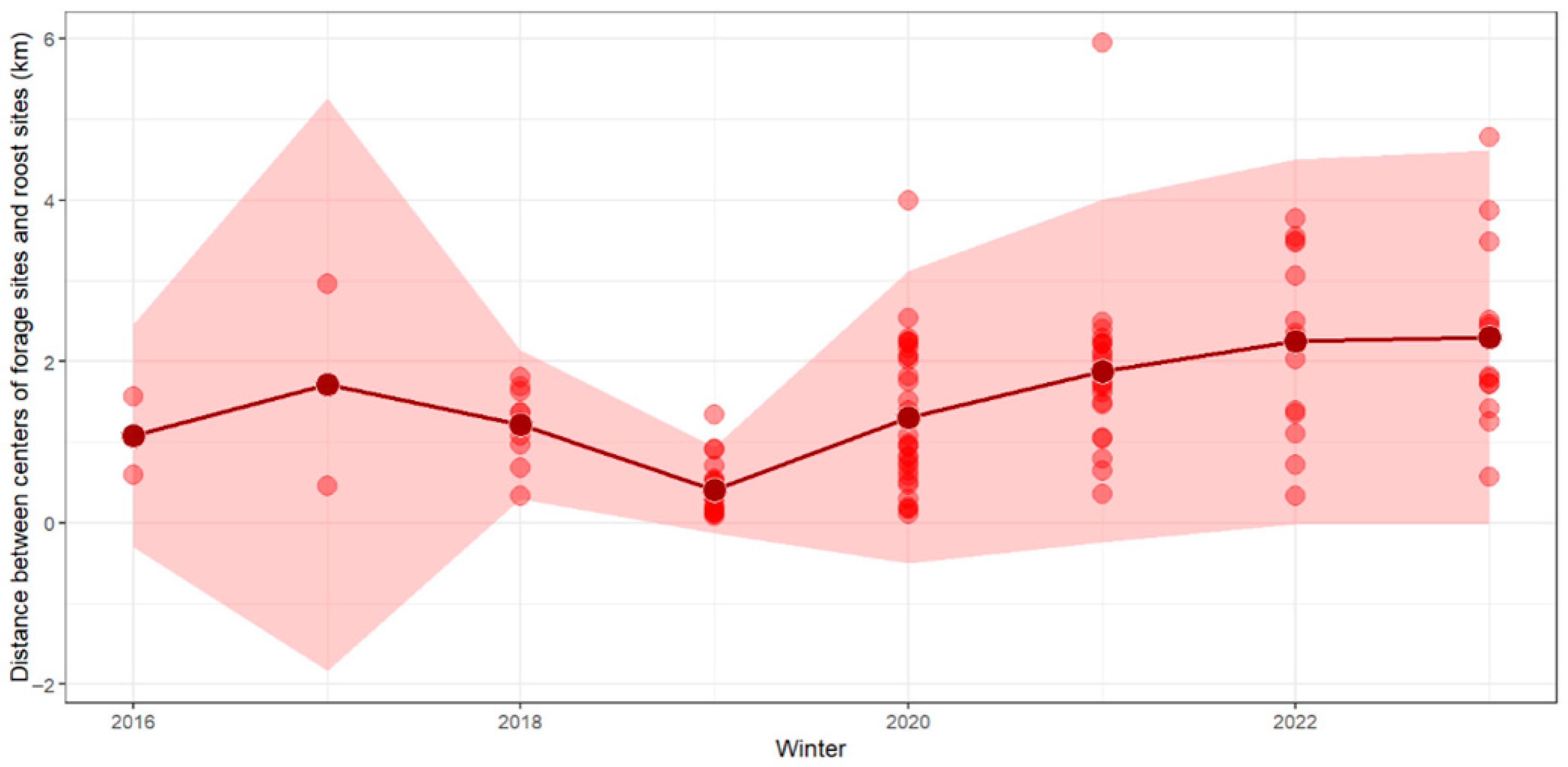
References
- Touma, D.; Ashfaq, M.; Nayak, M.A.; Kao, S.-C.; Diffenbaugh, N.S. A multi-model and multi-index evaluation of drought characteristics in the 21st century. J. Hydrol. 2015, 526, 196–207. [Google Scholar] [CrossRef]
- Mukherjee, S.; Mishra, A.; Trenberth, K.E. Climate change and drought: A perspective on drought indices. Curr. Clim. Change Rep. 2018, 4, 145–163. [Google Scholar] [CrossRef]
- Alexander, L.V.; Tapper, N.; Zhang, X.; Fowler, H.J.; Tebaldi, C.; Lynch, A. Climate extremes: Progress and future directions. Int. J. Climatol. 2009, 29, 317–319. [Google Scholar] [CrossRef]
- Cook, B.I.; Ault, T.R.; Smerdon, J.E. Unprecedented 21st century drought risk in the American Southwest and Central Plains. Sci. Adv. 2015, 1, e1400082. [Google Scholar] [CrossRef] [PubMed]
- Trenberth, K.E.; Dai, A.; Van Der Schrier, G.; Jones, P.D.; Barichivich, J.; Briffa, K.R.; Sheffield, J. Global warming and changes in drought. Nat. Clim. Change 2014, 4, 17–22. [Google Scholar] [CrossRef]
- Sheffield, J.; Wood, E.F.; Roderick, M.L. Little change in global drought over the past 60 years. Nature 2012, 491, 435–438. [Google Scholar] [CrossRef] [PubMed]
- IPCC. Climate Change 2022: Impacts, Adaptation, and Vulnerability. Working Group II Contribution to the Sixth Assessment Report of the Intergovernmental Panel on Climate Change; IPCC: Geneva, Switzerland, 2022. [Google Scholar]
- Vicente-Serrano, S.M.; Peña-Angulo, D.; Beguería, S.; Domínguez-Castro, F.; Tomás-Burguera, M.; Noguera, I.; Gimeno-Sotelo, L.; El Kenawy, A. Global drought trends and future projections. Philos. Trans. R. Soc. A Math. Phys. Eng. Sci. 2022, 380, 20210285. [Google Scholar] [CrossRef] [PubMed]
- Gao, X.; Liang, J.; Zhu, Z.; Li, W.; Lu, L.; Li, X.; Li, S.; Tang, N.; Li, X. Drought-induced changes in hydrological and phenological interactions modulate waterbird habitats dynamics. J. Hydrol. 2023, 626, 130228. [Google Scholar] [CrossRef]
- Barbaree, B.A.; Reiter, M.E.; Hickey, C.M.; Strum, K.M.; Isola, J.E.; Jennings, S.; Tarjan, L.M.; Strong, C.M.; Stenzel, L.E.; Shuford, W.D. Effects of drought on the abundance and distribution of non-breeding shorebirds in central California, USA. PLoS ONE 2020, 15, e0240931. [Google Scholar] [CrossRef]
- Herremans, M. Effects of drought on birds in the Kalahari, Botswana. Ostrich-J. Afr. Ornithol. 2004, 75, 217–227. [Google Scholar] [CrossRef]
- Jitariu, V.; Dorosencu, A.; Ichim, P.; Ion, C. Severe drought monitoring by remote sensing methods and its impact on wetlands birds assemblages in Nuntași and Tuzla Lakes (Danube Delta Biosphere Reserve). Land 2022, 11, 672. [Google Scholar] [CrossRef]
- Butler, M.J.; Metzger, K.L.; Harris, G. Whooping crane demographic responses to winter drought focus conservation strategies. Biol. Conserv. 2014, 179, 72–85. [Google Scholar] [CrossRef]
- Wang, X.; Kuang, F.; Tan, K.; Ma, Z. Population trends, threats, and conservation recommendations for waterbirds in China. Avian Res. 2018, 9, 14. [Google Scholar] [CrossRef]
- Yin, Z.; Zhou, B.; Duan, M.; Chen, H.; Wang, H. Climate extremes become increasingly fierce in China. Innovation 2023, 4, 100406. [Google Scholar] [CrossRef]
- Wang, C.; Xia, S.; Yu, X.; Wen, L. Responses to extreme drought in wintering waterbirds: A multi-species approach. Front. Zool. 2025, 22, 3. [Google Scholar] [CrossRef] [PubMed]
- Higuchi, H.; Pierre, J.P.; Krever, V.; Andronov, V.; Fujita, G.; Ozaki, K.; Goroshko, O.; Ueta, M.; Smirensky, S.; Mita, N. Using a remote technology in conservation: Satellite tracking White-naped cranes in Russia and Asia. Conserv. Biol. 2004, 18, 136–147. [Google Scholar] [CrossRef]
- Si, Y.; Xu, Y.; Xu, F.; Li, X.; Zhang, W.; Wielstra, B.; Wei, J.; Liu, G.; Luo, H.; Takekawa, J.; et al. Spring migration patterns, habitat use, and stopover site protection status for two declining waterfowl species wintering in China as revealed by satellite tracking. Ecol. Evol. 2018, 8, 6280–6289. [Google Scholar] [CrossRef]
- Zhu, Q.; Hobson, K.A.; Zhao, Q.; Zhou, Y.; Damba, I.; Batbayar, N.; Natsagdorj, T.; Davaasuren, B.; Antonov, A.; Guan, J.; et al. Migratory connectivity of Swan Geese based on species’ distribution models, feather stable isotope assignment and satellite tracking. Divers. Distrib. 2020, 26, 944–957. [Google Scholar] [CrossRef]
- Li, J.; Qian, F.; Zhang, Y.; Zhao, L.; Deng, W.; Ma, K. Identifying seasonal differences in migration characteristics of Oriental white stork (Ciconia boyciana) through satellite tracking and remote sensing. Ecol. Indic. 2023, 146, 109760. [Google Scholar] [CrossRef]
- Finlayson, M.; Harris, J.; McCartney, M.; Lew, Y.; Zhang, C. Report on Ramsar visit to Poyang Lake Ramsar site, PR China. In Proceedings of Secretariat of the Ramsar Convention; International Union for the Conservation of Nature: Gland, Switzerland, 2010. [Google Scholar]
- Wang, Y.; Molinos, J.G.; Shi, L.; Zhang, M.; Wu, Z.; Zhang, H.; Xu, J. Drivers and changes of the Poyang Lake wetland ecosystem. Wetlands 2019, 39, 35–44. [Google Scholar] [CrossRef]
- Suliman, M.; Deng, W.; Wu, Q.; Ahmad, T.; Sun, X.; Tsegaye, D.M.; Khan, M.S.; Trang, N.T.K.; Zou, H. Evaluation of lake fragmentation and its effect on wintering waterbirds in Poyang lake, china. Diversity 2024, 16, 154. [Google Scholar] [CrossRef]
- Shao, M.; Wang, J.; Ding, H.; Yang, F. Response of Siberian cranes (Grus leucogeranus) to hydrological changes and the availability of foraging habitat at various water levels in Poyang lake. Animals 2024, 14, 234. [Google Scholar] [CrossRef]
- Li, X.; Hu, B.; Qi, S.; Luo, J. The influence of short-term water level fluctuations on the habitat response and ecological fragility of Siberian cranes in Poyang lake, China. Remote Sens. 2024, 16, 4431. [Google Scholar] [CrossRef]
- Li, Y.; Dong, X.; Hu, C. The impact of ecological water level on wintering migratory birds in Poyang Lake—Focusing on phytophagous geese. Ecol. Indic. 2024, 169, 112946. [Google Scholar] [CrossRef]
- Shao, M.; Jiang, J.; Liao, Z. Population sizes and flocking features of wintering common cranes and white-naped cranes in Poyang Lake. J. Ecol. Rural. Environ. 2014, 30, 464–469. [Google Scholar]
- Fujita, G.; Guan, H.L.; Ueta, M.; Goroshko, O.; Krever, V.; Ozaki, K.; Mita, N.; Higuchi, H. Comparing areas of suitable habitats along travelled and possible shortest routes in migration of White-naped Cranes Grus vipio in East Asia. Ibis 2004, 146, 461–474. [Google Scholar] [CrossRef]
- Lang, X.; Purev-Ochir, G.; Terbish, O.; Khurelbaatar, D.; Erdenechimeg, B.; Gungaa, A.; Mi, C.; Guo, Y. Luan River upper reaches: The important stopover site of the white-naped crane (Grus vipio) western population. Biodivers. Sci. 2020, 28, 1213–1221, 0300–0307. [Google Scholar] [CrossRef]
- Guisan, A.; Thuiller, W. Predicting species distribution: Offering more than simple habitat models. Ecol. Lett. 2005, 8, 993–1009. [Google Scholar] [CrossRef] [PubMed]
- McShea, W.J. What are the roles of species distribution models in conservation planning? Environ. Conserv. 2014, 41, 93–96. [Google Scholar] [CrossRef]
- Li, X.H.; Wang, Y. Applying various algorithms for species distribution modeling. Integr. Zool. 2013, 8, 124–135. [Google Scholar] [CrossRef]
- Holloway, P.; Miller, J.A. A quantitative synthesis of the movement concepts used within species distribution modelling. Ecol. Model. 2017, 356, 91–103. [Google Scholar] [CrossRef]
- Wang, R.-N.; Liu, X.-B.; Chen, X.-K.; Han, Z.; Peng, W.-Q. Studies on the suitable ecological water level of Poyang Lake national nature reserve based on the habitat needs of white cranes. In Advances in Civil Engineering and Environmental Engineering; CRC Press: Boca Raton, FL, USA, 2023; Volume 2, pp. 421–428. [Google Scholar]
- Gong, P.; Wang, J.; Yu, L.; Zhao, Y.; Zhao, Y.; Liang, L.; Niu, Z.; Huang, X.; Fu, H.; Liu, S.; et al. Finer resolution observation and monitoring of global land cover: First mapping results with Landsat TM and ETM+ data. Int. J. Remote Sens. 2013, 34, 2607–2654. [Google Scholar] [CrossRef]
- Polidori, L.; El Hage, M. Digital elevation model quality assessment methods: A critical review. Remote Sens. 2020, 12, 3522. [Google Scholar] [CrossRef]
- Hijmans, R.J.; Cameron, S.E.; Parra, J.L.; Jones, P.G.; Jarvis, A. Very high resolution interpolated climate surfaces for global land areas. Int. J. Climatol. 2005, 25, 1965–1978. [Google Scholar] [CrossRef]
- Hijmans, R.J.; Van Etten, J.; Cheng, J.; Mattiuzzi, M.; Sumner, M.; Greenberg, J.A.; Lamigueiro, O.P.; Bevan, A.; Racine, E.B.; Shortridge, A. Package ‘raster’. R Package 2015, 734, 473. [Google Scholar]
- Breiman, L. Random forests. Mach. Learn. 2001, 45, 5–32. [Google Scholar] [CrossRef]
- Li, X.; Li, N.; Li, B.; Sun, Y.; Gao, E. abundanceR: A novel method for estimating wildlife abundance based on distance sampling and species distribution models. Land 2022, 11, 660. [Google Scholar] [CrossRef]
- Harris, J.; Liying, S.; Higuchi, H.; Ueta, M.; Zhengwang, Z.; Yanyun, Z.; Xijun, N. Migratory stopover and wintering locations in eastern China used by White-naped Cranes Grus vipio and Hooded Cranes G. monacha, as determined by satellite tracking. Forktail 2000, 16, 93–99. [Google Scholar]
- de Felipe, M.; Amat, J.A.; Arroyo, J.L.; Rodríguez, R.; Díaz-Paniagua, C. Habitat Changes at the Local Scale Have Major Impacts on Waterfowl Populations Across a Migratory Flyway. Glob. Change Biol. 2024, 30, e17600. [Google Scholar] [CrossRef]
- Pearse, A.T.; Caven, A.J.; Baasch, D.M.; Bidwell, M.T.; Conkin, J.A.; Brandt, D.A. Flexible migration and habitat use strategies of an endangered waterbird during hydrological drought. Conserv. Sci. Pract. 2024, 6, e13120. [Google Scholar] [CrossRef]
- Feng, X.; Merow, C.; Liu, Z.; Park, D.S.; Roehrdanz, P.R.; Maitner, B.; Newman, E.A.; Boyle, B.L.; Lien, A.; Burger, J.R. How deregulation, drought and increasing fire impact Amazonian biodiversity. Nature 2021, 597, 516–521. [Google Scholar] [CrossRef]
- Moore, H.A.; Cresswell, A.K. Drought in south-west Australia links to urban immigration across multiple avian taxa. Pac. Conserv. Biol. 2024, 30, PC24058. [Google Scholar] [CrossRef]
- Feng, L.; Shi, J.; Xiao, Y.; Liao, L.; Zhou, Z.; Xu, J.; Li, Y.; Tian, Y.; Niu, Y. Impact of Extreme Drought on Waterbird Abundance: A Case Study Based on the Core Nature Reserve and Surrounding Wetlands. Ecol. Evol. 2025, 15, e71258. [Google Scholar] [CrossRef]
- Zhang, P.; Zou, Y.; Tao, K.; Zhang, S.; Li, F.; Deng, Z.; Zeng, J.; Xie, Y.; Liu, X.; Li, F. Extreme drought alters waterfowl distribution patterns and spatial niches in floodplain wetlands. Glob. Ecol. Conserv. 2024, 51, e02901. [Google Scholar] [CrossRef]
- Xia, S.; Han, J.; Ji, X.; Zhou, L. Influence of extreme drought events on wintering waterbird metacommunities in high-water-level gate-controlled lake basin: A functional group perspective. Glob. Ecol. Conserv. 2025, 62, e03818. [Google Scholar] [CrossRef]
- Gao, X.; Liang, J.; Zhu, Z.; Li, W.; Lu, L.; Qiu, X.; Li, S.; Tang, N.; Li, X. Unraveling the impact of drought on waterbird community assembly and conservation strategies. J. Environ. Manag. 2025, 373, 123685. [Google Scholar] [CrossRef]
- Liu, X.; Yuan, L.; Li, Z.; Huang, Y.; Li, Y. Mapping Habitat Suitability of Migratory Birds During Extreme Drought of Large Lake Wetlands: Insights from Crowdsourced Geographic Data. Land 2025, 14, 1236. [Google Scholar] [CrossRef]
- Yan, Z.; Shao, M. Response of Landscape Types and Shorebird Diversity to Extreme Drought Climate in Poyang Lake, China During the Non-Breeding Period. Animals 2025, 15, 1399. [Google Scholar] [CrossRef]
- Wang, C.; Xia, S.; Yu, X.; Wen, L.; Choi, C.-Y. Artificial wetlands as drought refugia for wintering geese: Adaptive use or ecological mismatch? Biol. Conserv. 2026, 313, 111545. [Google Scholar] [CrossRef]
- Wang, Z.; Zhou, J.; He, Y.; Zhang, Y.; Liu, P.; Jia, Y.; Lu, C.; Lei, G. Spatially Diverse Water Levels Enhance Habitat Heterogeneity for Wintering Waterbirds. Freshwat. Biol. 2025, 70, e70016. [Google Scholar] [CrossRef]
- MacKenzie, D.I.; Nichols, J.D.; Lachman, G.B.; Droege, S.; Royle, J.A.; Langtimm, C.A. Estimating site occupancy rates when detection probabilities are less than one. Ecology 2002, 83, 2248–2255. [Google Scholar] [CrossRef]
- Vermeiren, P.; Reichert, P.; Schuwirth, N. Integrating uncertain prior knowledge regarding ecological preferences into multi-species distribution models: Effects of model complexity on predictive performance. Ecol. Model. 2020, 420, 108956. [Google Scholar] [CrossRef]
- Kling, M.M.; Baer, K.C.; Ackerly, D.D. A tree’s view of the terrain: Downscaling bioclimate variables to high resolution using a novel multi-level species distribution model. Ecography 2024, 2024, e07131. [Google Scholar] [CrossRef]
- Kleyheeg, E.; van Dijk, J.G.B.; Tsopoglou-Gkina, D.; Woud, T.Y.; Boonstra, D.K.; Nolet, B.A.; Soons, M.B. Movement patterns of a keystone waterbird species are highly predictable from landscape configuration. Mov. Ecol. 2017, 5, 2. [Google Scholar] [CrossRef] [PubMed]
- Wu, H.; Chen, J.; Xu, J.; Zeng, G.; Sang, L.; Liu, Q.; Yin, Z.; Dai, J.; Yin, D.; Liang, J. Effects of dam construction on biodiversity: A review. J. Clean. Prod. 2019, 221, 480–489. [Google Scholar] [CrossRef]
- Zhang, Q.; Xue, C.; Xia, J. Impacts, contributing factors and countermeasures of extreme droughts in Poyang Lake. Bull. Chin. Acad. Sci. 2023, 38, 1894–1902. (In Chinese) [Google Scholar] [CrossRef]
- Jiang, W.; Liu, B.; Li, Y.; Lu, C.; Shu, L. The effects of damming and dam regulation on a river–lake-aquifer system: 3D groundwater flow modeling of Poyang Lake (China). J. Hydrol. 2024, 636, 131311. [Google Scholar] [CrossRef]
- Li, K.; Zhu, C.; Wu, L.; Huang, L. Problems caused by the Three Gorges Dam construction in the Yangtze River basin: A review. Environ. Rev. 2013, 21, 127–135. [Google Scholar] [CrossRef]
- Clark, J.S.; Iverson, L.; Woodall, C.W.; Allen, C.D.; Bell, D.M.; Bragg, D.C.; D’Amato, A.W.; Davis, F.W.; Hersh, M.H.; Ibanez, I.; et al. The impacts of increasing drought on forest dynamics, structure, and biodiversity in the United States. Glob. Change Biol. 2016, 22, 2329–2352. [Google Scholar] [CrossRef]
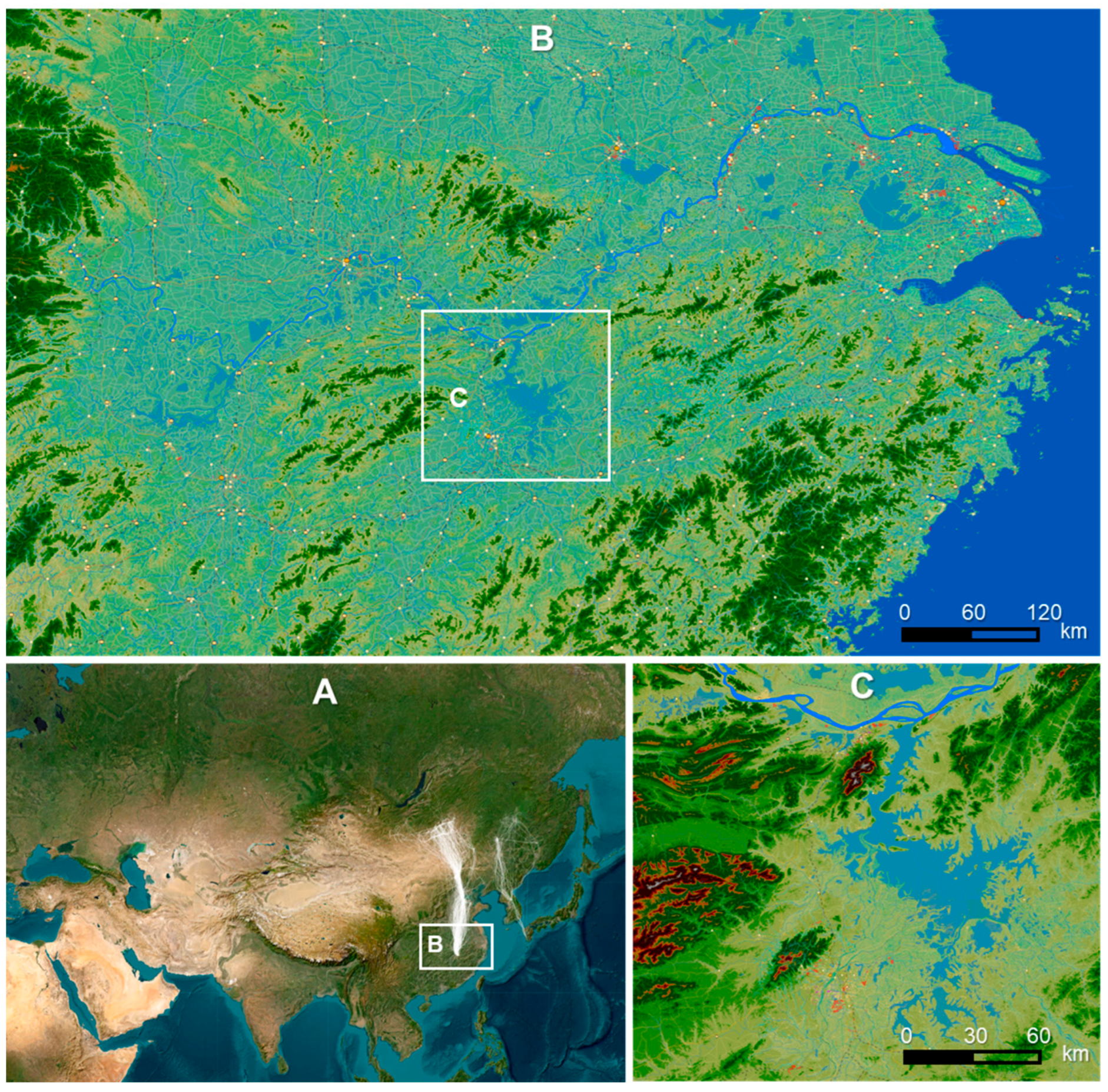


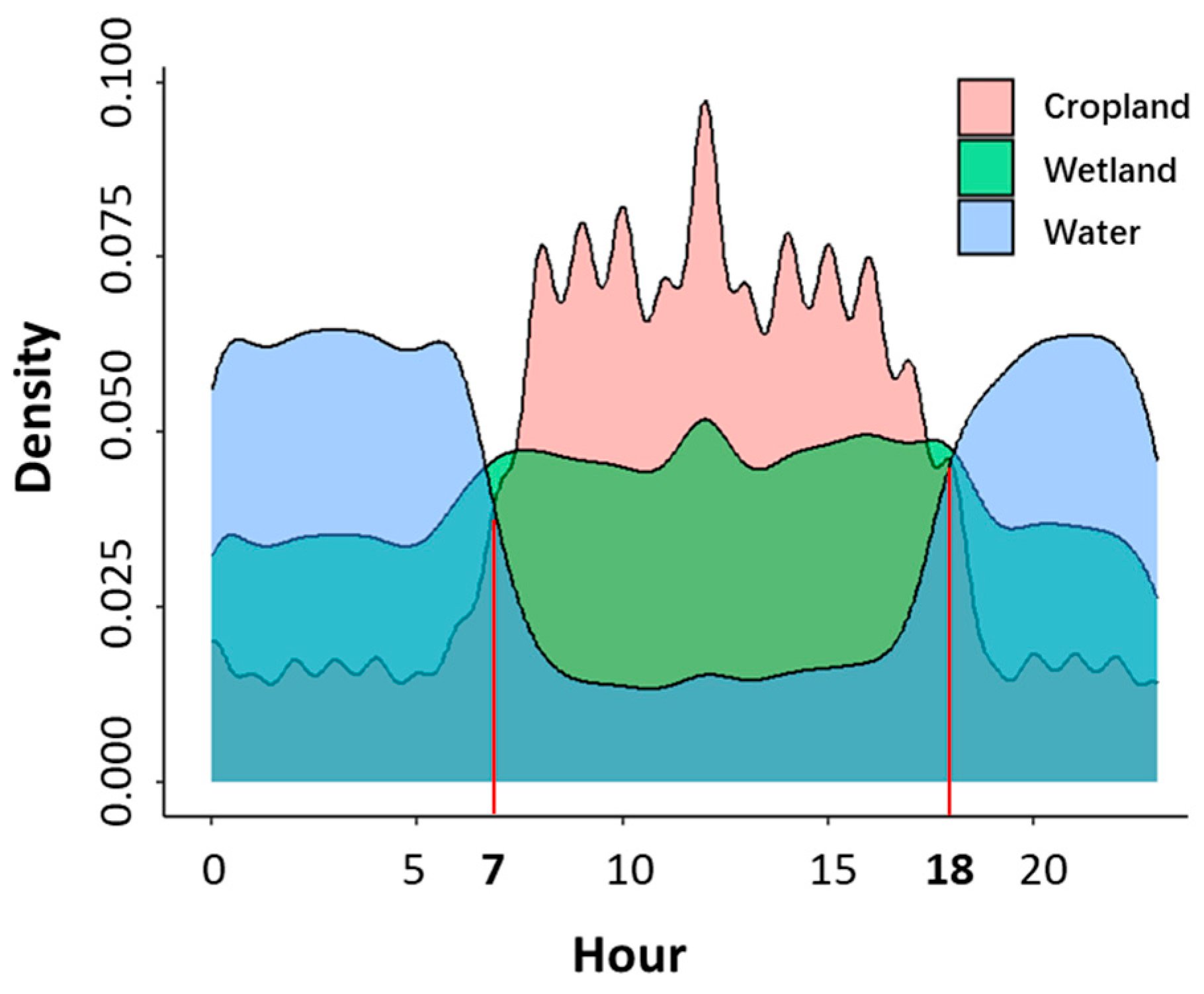
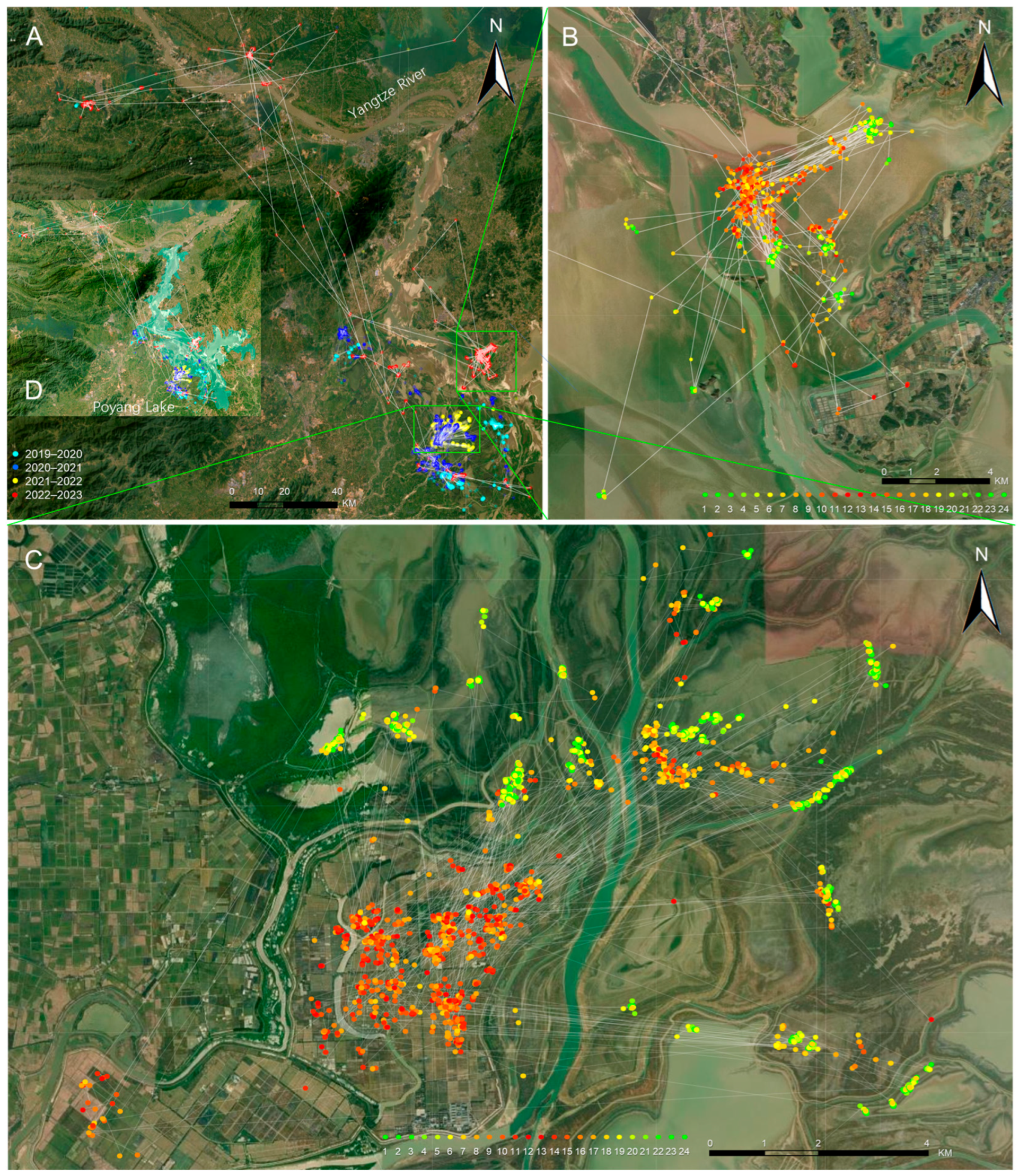

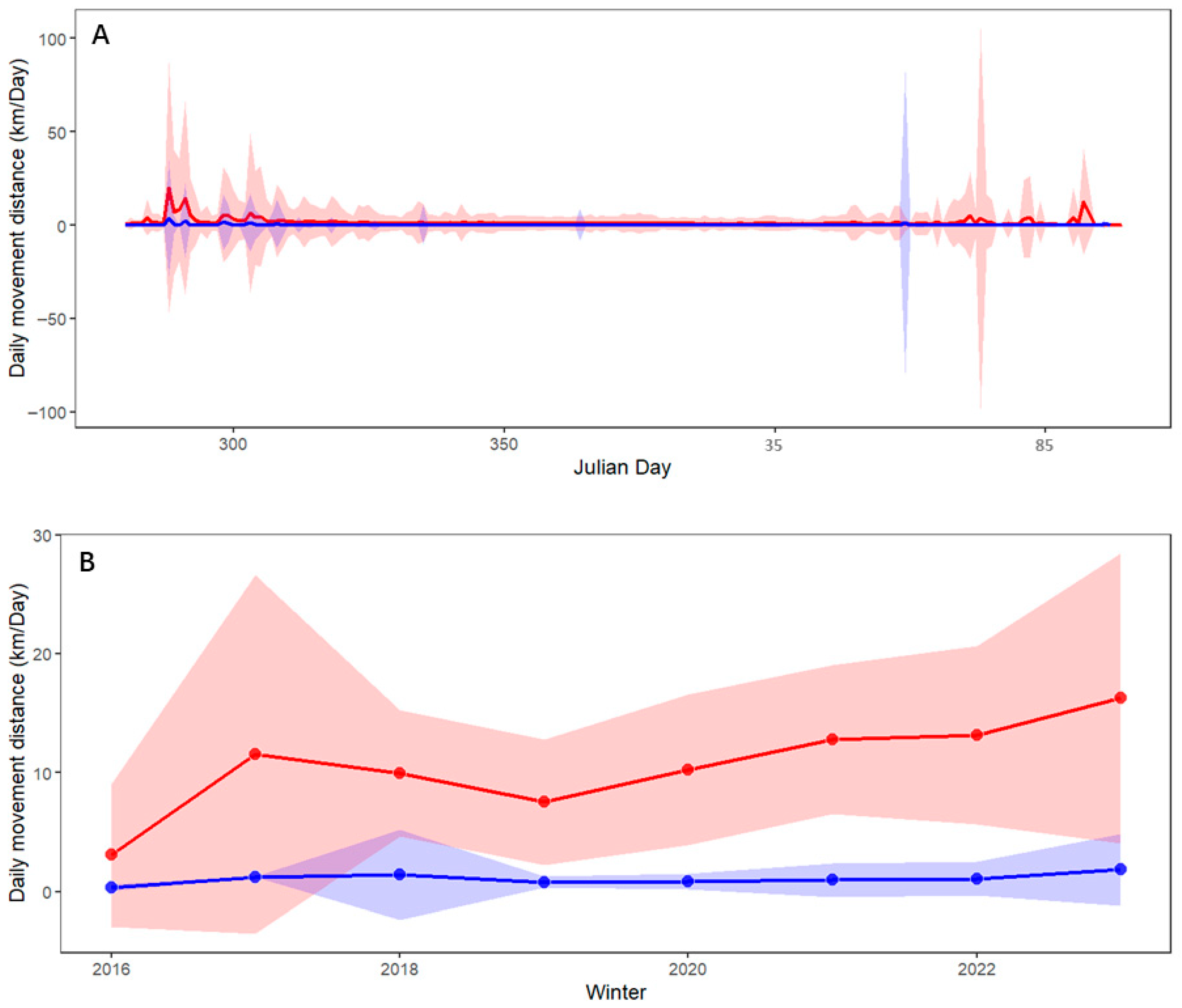
| Winters | Mean Daily Movement Distance (km) | No. of Cranes | Difference Comparing with 2022–2023 | Std. Error of the Difference | t Value | p Value |
|---|---|---|---|---|---|---|
| 2015–2016 | 3.37 | 2 | −10.17 | 3.42 | −2.98 | 0.0015 |
| 2016–2017 | 8.56 | 3 | −2.83 | 2.79 | −1.01 | 0.1558 |
| 2017–2018 | 11.55 | 11 | 0.42 | 1.69 | 0.25 | 0.4025 |
| 2018–2019 | 8.05 | 33 | −4.48 | 1.28 | −3.50 | 0.0002 |
| 2019–2020 | 9.96 | 37 | −2.93 | 1.24 | −2.37 | 0.0088 |
| 2020–2021 | 11.64 | 27 | −1.45 | 1.30 | −1.12 | 0.1318 |
| 2021–2022 | 10.49 | 19 | −2.49 | 1.39 | −1.79 | 0.0370 |
| 2022–2023 | 13.34 | 18 |
Disclaimer/Publisher’s Note: The statements, opinions and data contained in all publications are solely those of the individual author(s) and contributor(s) and not of MDPI and/or the editor(s). MDPI and/or the editor(s) disclaim responsibility for any injury to people or property resulting from any ideas, methods, instructions or products referred to in the content. |
© 2025 by the authors. Licensee MDPI, Basel, Switzerland. This article is an open access article distributed under the terms and conditions of the Creative Commons Attribution (CC BY) license (https://creativecommons.org/licenses/by/4.0/).
Share and Cite
Guo, Y.; Wen, L.; Nie, L.; Li, X. The Impacts of Severe Drought on Waterbirds: A Case Study for the White-Naped Crane in Poyang Lake Based on Satellite Telemetry. Sustainability 2025, 17, 10429. https://doi.org/10.3390/su172310429
Guo Y, Wen L, Nie L, Li X. The Impacts of Severe Drought on Waterbirds: A Case Study for the White-Naped Crane in Poyang Lake Based on Satellite Telemetry. Sustainability. 2025; 17(23):10429. https://doi.org/10.3390/su172310429
Chicago/Turabian StyleGuo, Yumin, Lijia Wen, Lin Nie, and Xinhai Li. 2025. "The Impacts of Severe Drought on Waterbirds: A Case Study for the White-Naped Crane in Poyang Lake Based on Satellite Telemetry" Sustainability 17, no. 23: 10429. https://doi.org/10.3390/su172310429
APA StyleGuo, Y., Wen, L., Nie, L., & Li, X. (2025). The Impacts of Severe Drought on Waterbirds: A Case Study for the White-Naped Crane in Poyang Lake Based on Satellite Telemetry. Sustainability, 17(23), 10429. https://doi.org/10.3390/su172310429








